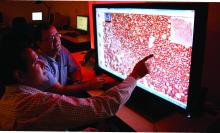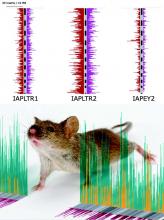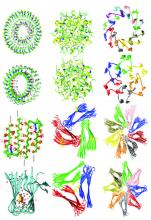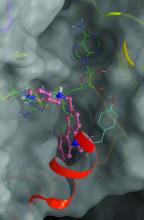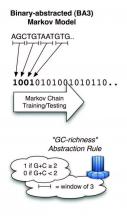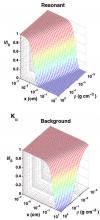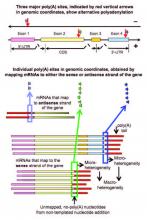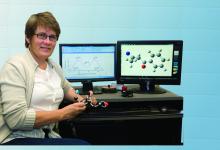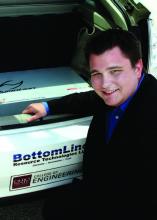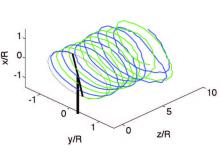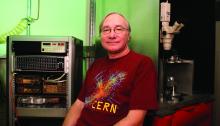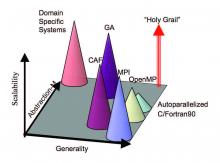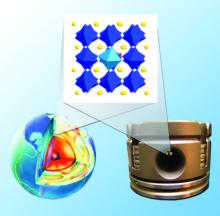Follicular Lymphoma (FL) is one of the most common forms of non-Hodgkin Lymphoma occurring in the United States. FL is a slow-growing cancer of the human lymph system that usually spreads into the blood, bone marrow and, eventually, internal organs.
2010 Research Report
Recently, large-scale sequencing projects have described the complete DNA blueprints for humans, the mouse and other organisms. This work highlighted the surprising fact that almost half of all mammalian DNA genomes is made up of mobile genetic elements called retrotransposons.
Alzheimer’s disease is the most common human neurodegenerative disorder, affecting as many as 5.1 million people in America alone. Alzheimer’s leads to progressive and irreversible memory loss, disability and, eventually, death through a complex series of events that take place in the brain over a period of many years.
Chenglong Li, Ph.D., an assistant professor in the College of Pharmacy at The Ohio State University, is using computational chemistry to help develop a genetically targeted drug that could surpass current approaches to treating a type of aggressive brain tumor called glioblastoma multiforme (GBM).
The first human genome took 15 years and about $3 billion to complete. Soon, doctors at The Research Institute at Nationwide Children’s Hospital will be able to sequence two human genomes in just over one week for a fraction of that cost.
Samuel Shepard, Ph.D., a researcher in the University of Toledo bioinformatics lab of Associate Professor Alexei Fedorov, recently developed an algorithm for the prediction of certain genomic sequences, known as exons and introns, using midrange sequences of 20-50 nucleotides in length.
Two Ohio State University astronomy researchers have established an international reputation for using X-rays and supercomputers to search the vast depths of space to identify elusive black holes. Now, they and their interdisciplinary colleagues are repositioning their scientific methodology to peer into the human body to enhance cancer therapy and diagnostics (theranostics).
When eukaryotic genes are expressed, precursor messenger RNA (pre-mRNA) must first be processed to become mature mRNA. One step of the maturation process is constitutive polyadenylation: the attachment of a poly(A) tail to mark and protect the end of mRNA.
Fundamental research in chemistry has laid the foundations for the discovery and design of new materials with fascinating magnetic, electrical and optical properties, prompting inventions anywhere from faster computers to lighter long-range planes.
Surprising behaviors often arise when small numbers of atoms and molecules are brought into close proximity. Such small aggregates offer a window into an intermediate state of matter between isolated atoms and bulk materials.
Ohio State University researchers recently discovered potential keys to mass producing a specific pattern of graphite in a layer just one atom thick, signaling a breakthrough that could lead to “graphene” challenging silicon as the preferred material for manufacturing faster, more efficient computer chips.
Modern flashlights with bright, white LEDs probably use a mixed indium-gallium nitride alloy as semiconductor to convert electricity into light. A Blu-ray disk system also employs a blue InGaN-based laser. However, indium is becoming scarce and costly, sending researchers scurrying to find an alternative technology.
Organic photovoltaic systems (OPVs) have generated considerable interest from researchers in recent years as materials relevant to harnessing renewable and sustainable sources of solar energy. OPVs are called "organic" because the substances are carbon-based, like the molecules of living things.
Various materials can be used to control the path of light or any other type of electromagnetic (EM) wave. For example, the lenses in a pair of eyeglasses are shaped to achieve a desired optical function.
David Bromwich, Ph.D., and his research team are leveraging the computing and storage resources of the Ohio Supercomputer Center (OSC) to synthesize historical weather data from a region of nearly 29-million square miles – everything north of Minneapolis, Minn.; Turin, Italy; and the Black Sea. The team is integrating multiple enormous databases containing eleven years of satellite readings and
The complex unsteady airflow characteristics of certain aircraft features, such as landing gears and weapon bays, produce pressure fluctuations that reach unacceptable levels for operation and safety at transonic speeds.
Nuclear fusion holds the promise of sustainable, abundant clean energy. Scientists have successfully demonstrated controlled fusion in the laboratory, but have not yet been able to demonstrate useful energy production.
When the Deepwater Horizon oil rig exploded off the Louisiana coast in April, it caused the first major deepsea oil spill and became the first spill where chemical dispersants were used far below the water’s surface. Researchers have detected toxic microdroplets spreading in concentrations that may be lethal to wildlife.
The power needs for extended all-electric operation of plug-in hybrid electric vehicles (PHEVs) require much more on-board energy than the lower-density energy typically provided by nickel-metal-hydride batteries. The current engineering solution is to link several parallel strings of lithium-ion battery cells within a battery module and to link several modules into larger battery packs.
Renewable energy is increasingly important with rising energy demands, finite fossil fuel supplies and growing environmental concerns.
With more than 70 percent of the Earth’s surface covered in water, studying ocean topography is vital to researchers who produce atmospheric models for forecasting hurricanes, optimizing commercial shipping routes, tracking floating debris and helping manage marine animal populations.
In April, physicists working on the ALICE project (short for A Large Ion Collider Experiment) began recording data from collisions within the Large Hadron Collider, operated by the European Laboratory for Nuclear Research (CERN) near Geneva, Switzerland.
A former British army officer once said, “History is littered with the Wars which everybody knew would never happen.”
Message Passing Interface (MPI) is the dominant parallel computing model on supercomputers today, including petascale systems that are capable of executing one quadrillion operations per second. MPI allows the thousands of nodes in these large clusters to “talk” with one another over high-speed, internal networks, such as
The highly ambiguous nature of natural language presents many challenges to researchers who design software to analyze, understand and generate languages that humans use naturally.
The Partitioned Global Address Space (PGAS) programming model has attracted considerable attention in HPC circles, primarily because it offers application programmers the convenience of globally addressable memory along with the locality control needed for scalability.
School children learn that nearly three-quarters of the Earth’s surface is covered with water, in the form of oceans, ice, rivers and lakes. However, even our brightest scientists know little about the distribution of water beneath the planet’s surface or even how much total water the planet contains.
Prasad Calyam, Ph.D., a senior systems developer and engineer for the Ohio Supercomputer Center (OSC) and Ohio Academic Resources Network (OARnet), is devising methods to improve the performance of next-generation computer networks.
